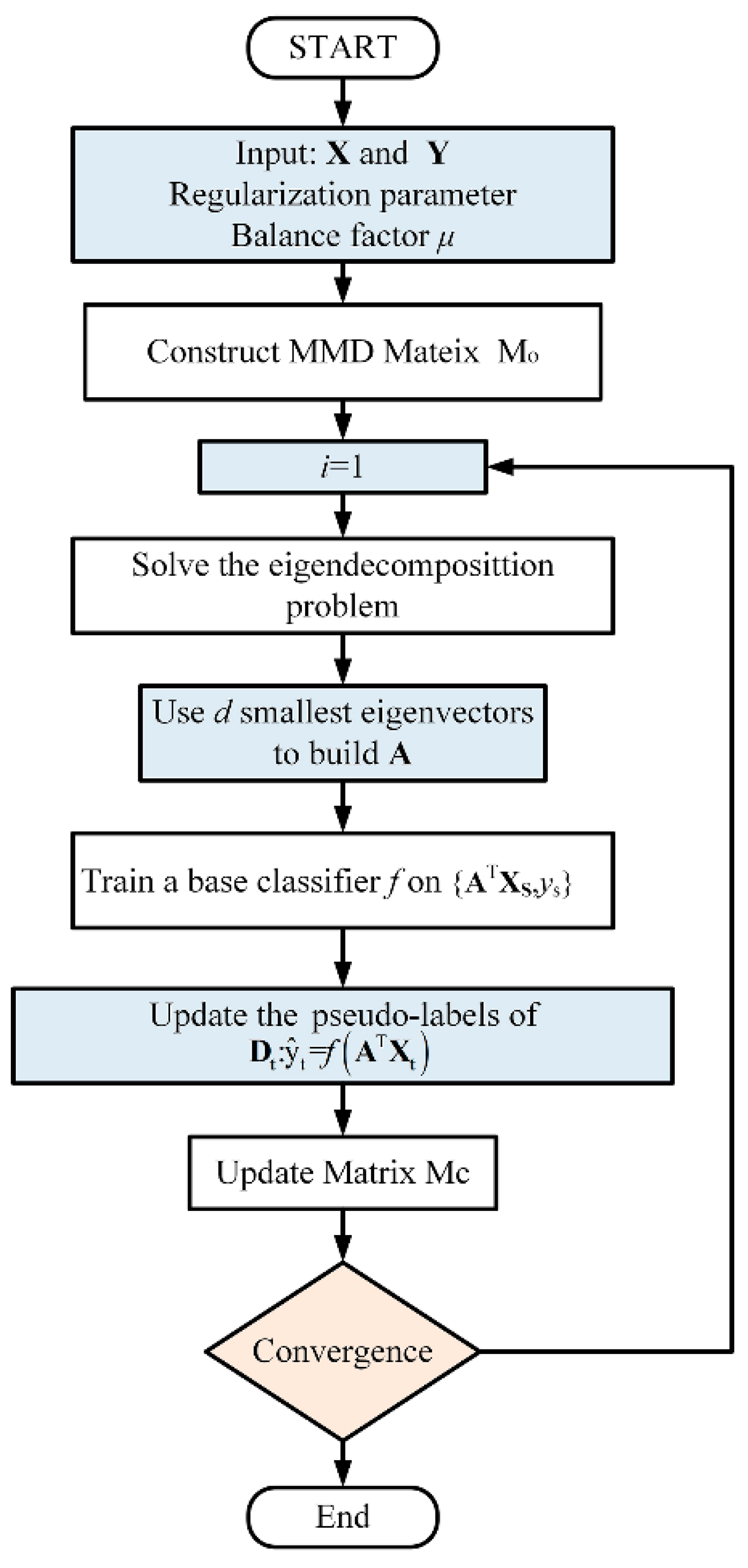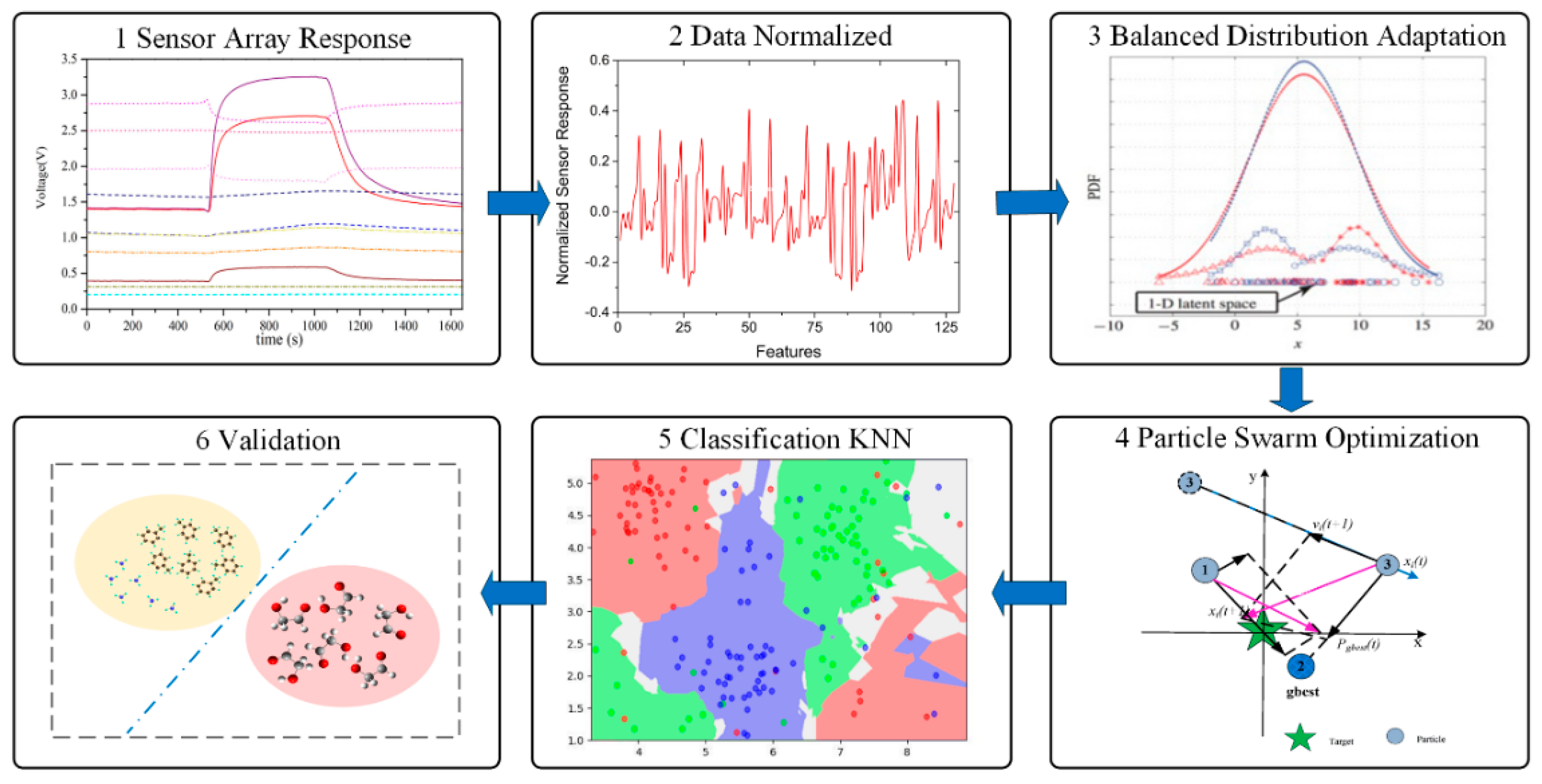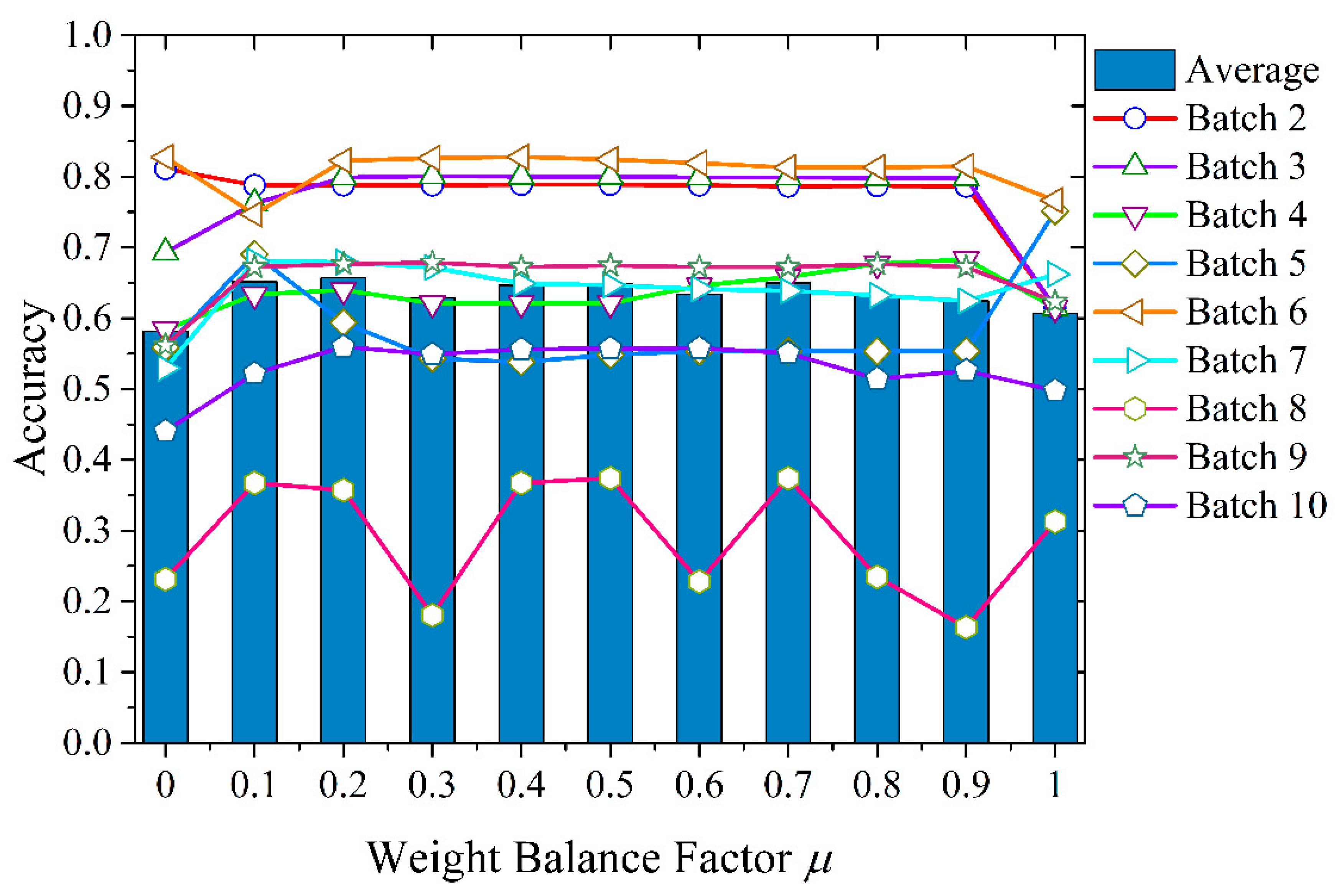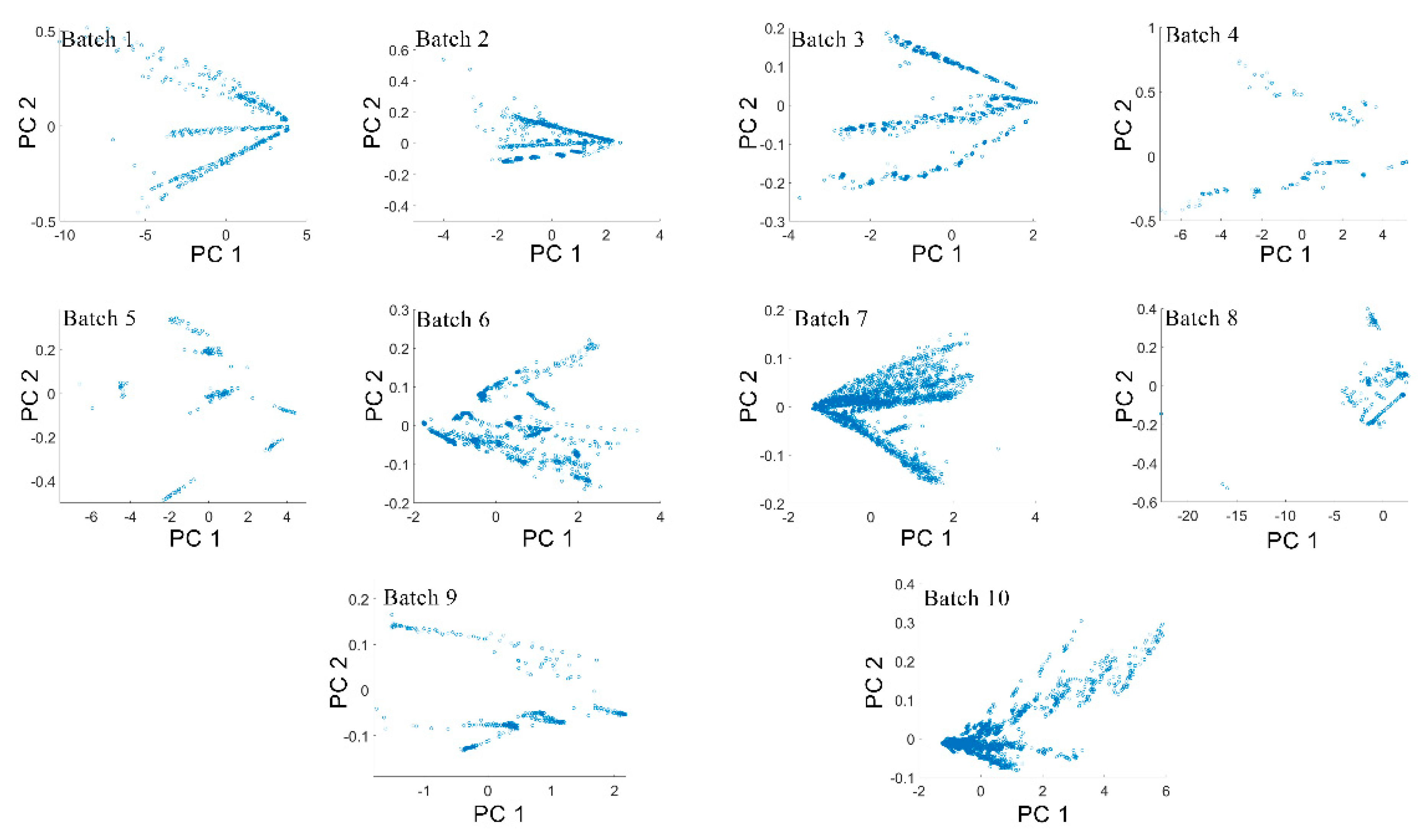Balanced Distribution Adaptation for Metal Oxide Semiconductor Gas Sensor Array Drift Compensation
Abstract
1. Introduction
2. Theoretical Background
2.1. Transfer Learning
2.2. Balanced Distribution Adaptation
2.3. K-Nearest Neighbors
2.4. Particle Swarm Optimization of BDA Parameters
- Initialization: first, set the number of iterations, the size of the particle swarm, and the position and speed range of the particle swarm. Initialize the initial velocity and position of each particle randomly in the velocity space and the search space. The fitness function is selected as the BDA model.
- Initial original optimal solution: solve individual extreme points for each particle initially randomly, and obtain a global optimal solution from it, which is recorded as a single global optimal solution.
- Update speed and position: According to Equations (9) and (10), update the speed and position of the next iteration.where w (w > 0) is the inertia factor. The value of w represents the strength of the system’s global and local optimization capabilities. C1 and C2 are self-learning factors and group-learning factors, respectively, and generally take . Pid represents the d-th dimension of the individual extreme value of the i-th variable. Pgd represents the d-th dimension of the global optimal solution.
- Iteration termination: when the set number of iterations is reached or within the allowable error range.
3. Drift Compensation Methodology and Data Set
3.1. Data Set for Validation
3.2. Drift Compensation BDA Method Methodology
4. Experiment and Result Analysis
4.1. Experimental Settings and BDA Parameters Configuration
- Setting 1:
- Set batch 1 (source domain) as a fixed training set and tested on batch K, K = 2,…, 10 (target domains);
- Setting 2:
- The training set (source domain) is dynamically changed with batch K-1 and tested on batch K (target domain), K = 2,…, 10.
4.2. Performance Verification
5. Conclusions
Author Contributions
Funding
Institutional Review Board Statement
Informed Consent Statement
Data Availability Statement
Conflicts of Interest
References
- Burgués, J.; Jiménez-Soto, J.M.; Marco, S. Estimation of the limit of detection in semiconductor gas sensors through linearized calibration models. Anal. Chim. Acta 2018, 1013, 13–25. [Google Scholar] [CrossRef]
- Xu, P.; Wei, G.; Song, K.; Chen, Y. High-accuracy health prediction of sensor systems using improved relevant vector-machine ensemble regression. Knowl. Based Syst. 2021, 212, 106555. [Google Scholar] [CrossRef]
- Cui, S.; Ling, P.; Zhu, H.; Keener, H.M. Plant Pest Detection Using an Artificial Nose System: A Review. Sensors 2018, 18, 378. [Google Scholar] [CrossRef] [PubMed]
- Chen, L.-Y.; Wu, C.-C.; Chou, T.-I.; Chiu, S.-W.; Tang, K.-T. Development of a Dual MOS Electronic Nose/Camera System for Improving Fruit Ripeness Classification. Sensors 2018, 18, 3256. [Google Scholar] [CrossRef]
- Song, K.; Xu, P.; Wei, G.; Chen, Y.; Wang, Q. Health Management Decision of Sensor System Based on Health Reliability Degree and Grey Group Decision-Making. Sensors 2018, 18, 2316. [Google Scholar] [CrossRef] [PubMed]
- Gasparri, R.; Sedda, G.; Spaggiari, L. The Electronic Nose’s Emerging Role in Respiratory Medicine. Sensors 2018, 18, 3029. [Google Scholar] [CrossRef]
- Velmathi, G.; Mohan, S.; Henry, R. Analysis and Review of Tin Oxide-Based Chemoresistive Gas Sensor. IETE Tech. Rev. 2016, 33, 323–331. [Google Scholar] [CrossRef]
- Kwoka, M.; Szuber, J. Studies of NO2 Gas-Sensing Characteristics of a Novel Room-Temperature Surface-Photovoltage Gas Sensor Device. Sensors 2020, 20, 408. [Google Scholar] [CrossRef] [PubMed]
- Nikolic, M.V.; Milovanovic, V.; Vasiljevic, Z.Z.; Stamenkovic, Z. Semiconductor Gas Sensors: Materials, Technology, Design, and Application. Sensors 2020, 20, 6694. [Google Scholar] [CrossRef]
- Neri, G. First Fifty Years of Chemoresistive Gas Sensors. Chemosens. 2015, 3, 1–20. [Google Scholar] [CrossRef]
- De Vito, S.; Fattoruso, G.; Pardo, M.S.; Tortorella, F.; Di Francia, G. Semi-Supervised Learning Techniques in Artificial Olfaction: A Novel Approach to Classification Problems and Drift Counteraction. IEEE Sens. J. 2012, 12, 3215–3224. [Google Scholar] [CrossRef]
- Feng, S.; Farha, F.; Li, Q.; Wan, Y.; Xu, Y.; Zhang, T.; Ning, H. Review on Smart Gas Sensing Technology. Sensors 2019, 19, 3760. [Google Scholar] [CrossRef] [PubMed]
- Vergara, A.; Vembu, S.; Ayhan, T.; Ryan, M.A.; Homer, M.L.; Huerta, R. Chemical gas sensor drift compensation using classifier ensembles. Sens. Actuators B Chem. 2012, 166–167, 320–329. [Google Scholar] [CrossRef]
- Lei, Z.; Zhang, D. Domain Adaptation Extreme Learning Machines for Drift Compensation in E-Nose Systems. IEEE Transact. Instrum. Measur. 2015, 64, 1790–1801. [Google Scholar]
- Liu, Q.; Hu, X.; Ye, M.; Cheng, X.; Li, F. Gas Recognition under Sensor Drift by Using Deep Learning. Int. J. Intell. Syst. 2015, 30, 907–922. [Google Scholar] [CrossRef]
- Luo, Y.; Wei, S.; Chai, Y.; Sun, X. Electronic Nose Sensor Drift Compensation based on Deep Belief Network. In Proceedings of the 2016 35th Chinese Control Conference (CCC), Chengdu, China, 27–29 July 2016; pp. 3951–3955. [Google Scholar]
- Yan, K.; Kou, L.; Zhang, D. Learning Domain-Invariant Subspace Using Domain Features and Independence Maximization. IEEE Trans. Cybern. 2017, 48, 288–299. [Google Scholar] [CrossRef]
- Liu, B.; Zeng, X.; Tian, F.; Zhang, S.; Zhao, L. Domain Transfer Broad Learning System for Long-Term Drift Compensation in Electronic Nose Systems. IEEE Access 2019, 7, 143947–143959. [Google Scholar] [CrossRef]
- Liu, T.; Chen, Y.; Li, D.; Yang, T.; Cao, J.; Wu, M. Drift Compensation for an Electronic Nose by Adaptive Subspace Learning. IEEE Sens. J. 2020, 20, 337–347. [Google Scholar] [CrossRef]
- Leon-Medina, J.X.; Pineda-Munoz, W.A.; Burgos, D.A.T. Joint Distribution Adaptation for Drift Correction in Electronic Nose Type Sensor Arrays. IEEE Access 2020, 8, 134413–134421. [Google Scholar] [CrossRef]
- Pan, S.J.; Yang, Q. A Survey on Transfer Learning. IEEE Trans. Knowl. Data Eng. 2010, 22, 1345–1359. [Google Scholar] [CrossRef]
- Wang, J.; Chen, Y.; Hao, S.; Feng, W.; Shen, Z. Balanced Distribution Adaptation for Transfer Learning. In Proceedings of the 2017 IEEE International Conference on Data Mining (ICDM), New Orleans, LA, USA, 18–21 November 2017; pp. 1129–1134. [Google Scholar]
- Kouw, W.M.; Loog, M. A Review of Domain Adaptation without Target Labels. IEEE Trans. Pattern Anal. Mach. Intell. 2021, 43, 766–785. [Google Scholar] [CrossRef] [PubMed]
- Sun, F.; Wu, H.; Luo, Z.; Gu, W.; Yan, Y.; Du, Q. Informative Feature Selection for Domain Adaptation. IEEE Access 2019, 7, 142551–142563. [Google Scholar] [CrossRef]
- Hoffman, J.; Rodner, E.; Donahue, J.; Kulis, B.; Saenko, K. Asymmetric and Category Invariant Feature Transformations for Domain Adaptation. Int. J. Comput. Vis. 2014, 109, 28–41. [Google Scholar] [CrossRef]
- Duan, L.; Xu, D.; Tsang, I.W.; Luo, J. Visual event recognition in videos by learning from web data. IEEE Comput. Soc. Conf. Comput. Vis. Pattern Recognit. 2010, 34, 1959–1966. [Google Scholar] [CrossRef]
- Rodriguez-Lujan, I.; Fonollosa, J.; Vergara, A.; Homer, M.; Huerta, R. On the calibration of sensor arrays for pattern recognition using the minimal number of experiments. Chemom. Intell. Lab. Syst. 2014, 130, 123–134. [Google Scholar] [CrossRef]









| Batch ID | Month | 1 Ethanol | 2 Ethylene | 3 Ammonia | 4 Acetaldehyde | 5 Acetone | 6 Toluene |
|---|---|---|---|---|---|---|---|
| Batch 1 | 1, 2 | 83 | 30 | 70 | 98 | 90 | 74 |
| Batch 2 | 3~10 | 100 | 109 | 532 | 334 | 164 | 5 |
| Batch 3 | 11~13 | 216 | 240 | 275 | 490 | 365 | 0 |
| Batch 4 | 14, 15 | 12 | 30 | 12 | 43 | 64 | 0 |
| Batch 5 | 16 | 20 | 46 | 63 | 40 | 28 | 0 |
| Batch 6 | 17~20 | 110 | 29 | 606 | 574 | 514 | 467 |
| Batch 7 | 21 | 360 | 744 | 630 | 662 | 649 | 568 |
| Batch 8 | 22, 23 | 40 | 33 | 143 | 30 | 30 | 18 |
| Batch 9 | 24, 30 | 100 | 75 | 78 | 55 | 61 | 101 |
| Batch 10 | 36 | 600 | 600 | 600 | 600 | 600 | 600 |
| Factor μ | 0 | 0.1 | 0.2 | 0.3 | 0.4 | 0.5 | 0.6 | 0.7 | 0.8 | 0.9 | 1.0 |
|---|---|---|---|---|---|---|---|---|---|---|---|
| Batch 2 | 81.11 | 78.78 | 78.78 | 78.78 | 78.86 | 78.86 | 78.78 | 78.62 | 78.70 | 78.62 | 61.49 |
| Batch 3 | 69.29 | 76.23 | 79.89 | 80.08 | 80.01 | 80.01 | 79.89 | 79.89 | 79.82 | 79.76 | 61.49 |
| Batch 4 | 58.39 | 63.35 | 63.98 | 62.11 | 62.11 | 62.11 | 64.60 | 65.84 | 67.70 | 68.32 | 61.49 |
| Batch 5 | 55.84 | 69.04 | 59.39 | 54.31 | 53.81 | 54.82 | 55.33 | 55.33 | 55.33 | 55.33 | 75.13 |
| Batch 6 | 82.74 | 74.70 | 82.26 | 82.61 | 82.78 | 82.43 | 81.91 | 81.30 | 81.30 | 81.48 | 76.65 |
| Batch 7 | 52.92 | 68.09 | 67.92 | 67.17 | 64.90 | 64.68 | 64.13 | 63.85 | 63.22 | 62.44 | 66.21 |
| Batch 8 | 23.13 | 36.73 | 35.71 | 18.03 | 36.73 | 37.41 | 22.79 | 37.41 | 23.47 | 16.33 | 31.29 |
| Batch 9 | 56.17 | 67.23 | 67.66 | 67.87 | 67.23 | 67.45 | 67.23 | 67.23 | 67.66 | 67.23 | 62.34 |
| Batch 10 | 44.06 | 52.19 | 55.97 | 54.89 | 55.61 | 55.75 | 55.78 | 55.06 | 51.44 | 52.58 | 49.78 |
| Average | 58.18 | 65.15 | 65.73 | 62.87 | 64.67 | 64.84 | 63.38 | 64.95 | 63.18 | 62.45 | 60.65 |
| Method | BDA RBF | BDA Linear | BDA Primal | |||
|---|---|---|---|---|---|---|
| μ | Acc | μ | Acc | μ | Acc | |
| Batch 2 | 0.000 | 81.11 | 0.000 | 80.23 | 0.012 | 82.23 |
| Batch 3 | 0.251 | 80.71 | 0.928 | 76.17 | 0.256 | 84.17 |
| Batch 4 | 0.931 | 68.32 | 0.842 | 68.94 | 0.658 | 68.94 |
| Batch 5 | 0.134 | 71.07 | 0.078 | 57.36 | 0.367 | 60.91 |
| Batch 6 | 0.912 | 84.65 | 0.033 | 86.61 | 0.148 | 84.61 |
| Batch 7 | 0.084 | 69.78 | 0.917 | 69.80 | 0.803 | 69.28 |
| Batch 8 | 0.533 | 38.10 | 0.297 | 32.65 | 0.700 | 32.31 |
| Batch 9 | 0.188 | 68.09 | 0.700 | 67.23 | 0.907 | 55.74 |
| Batch 10 | 0.690 | 58.44 | 0.651 | 59.56 | 0.961 | 53.72 |
| Average | 68.92 | 66.45 | 65.77 | |||
| Method | BDA RBF | BDA Linear | BDA Primal | |||
|---|---|---|---|---|---|---|
| μ | Acc | μ | Acc | μ | Acc | |
| Batch 1 → 2 | 0.000 | 82.72 | 0.000 | 80.23 | 0.012 | 82.24 |
| Batch 2 → 3 | 0.387 | 97.95 | 0.762 | 87.45 | 0.068 | 93.00 |
| Batch 3 → 4 | 0.785 | 73.83 | 0.683 | 90.06 | 0.700 | 81.99 |
| Batch 4 → 5 | 0.914 | 96.36 | 0.848 | 95.43 | 0.462 | 96.45 |
| Batch 5 → 6 | 0.903 | 76.25 | 0.537 | 74.30 | 0.798 | 73.87 |
| Batch 6 → 7 | 0.922 | 89.19 | 0.474 | 86.91 | 0.997 | 86.41 |
| Batch 7 → 8 | 0.888 | 66.85 | 0.730 | 61.90 | 0.000 | 58.16 |
| Batch 8 → 9 | 0.966 | 98.28 | 0.055 | 88.51 | 0.551 | 88.94 |
| Batch 9 → 10 | 0.001 | 48.15 | 0.892 | 48.50 | 0.509 | 50.72 |
| Average | 81.06 | 79.26 | 79.09 | |||
| Method | Batch 2 | Batch 3 | Batch 4 | Batch 5 | Batch 6 | Batch 7 | Batch 8 | Batch 9 | Batch 10 | Average |
|---|---|---|---|---|---|---|---|---|---|---|
| BDA RBF | 81.11 | 80.71 | 68.32 | 71.07 | 84.65 | 69.78 | 38.10 | 68.09 | 58.44 | 68.92 |
| BDA Linear | 80.23 | 76.17 | 68.94 | 57.36 | 86.61 | 69.80 | 32.65 | 67.23 | 59.56 | 66.45 |
| BDA Primal | 82.23 | 84.17 | 68.94 | 60.91 | 84.61 | 69.28 | 32.31 | 55.74 | 53.72 | 65.77 |
| JDA RBF | 78.54 | 79.26 | 70.19 | 56.35 | 83.09 | 73.12 | 49.32 | 55.53 | 34.00 | 64.38 |
| JDA Linear | 78.38 | 60.97 | 67.08 | 49.24 | 75.00 | 76.67 | 23.13 | 54.04 | 35.83 | 57.82 |
| JDA Primal | 79.42 | 79.45 | 62.73 | 70.56 | 70.48 | 62.75 | 16.67 | 67.87 | 51.28 | 62.36 |
| NN | 73.23 | 76.10 | 60.25 | 64.47 | 71.91 | 51.95 | 31.97 | 45.96 | 34.39 | 56.69 |
| Method | 1 → 2 | 2 → 3 | 3 → 4 | 4 → 5 | 5 → 6 | 6 → 7 | 7 → 8 | 8 → 9 | 9 → 10 | Average |
|---|---|---|---|---|---|---|---|---|---|---|
| BDA RBF | 82.72 | 97.95 | 73.83 | 96.36 | 76.25 | 89.19 | 66.85 | 98.28 | 48.15 | 81.06 |
| BDA Linear | 80.23 | 87.45 | 90.06 | 95.43 | 74.30 | 86.91 | 61.90 | 88.51 | 48.50 | 79.26 |
| BDA Primal | 82.24 | 93.00 | 81.99 | 96.45 | 73.87 | 86.41 | 58.16 | 88.94 | 50.72 | 79.09 |
| JDA RBF | 78.54 | 48.49 | 79.50 | 83.76 | 73.74 | 90.04 | 69.73 | 87.87 | 37.92 | 72.18 |
| JDA Linear | 78.28 | 51.60 | 78.26 | 95.43 | 67.35 | 87.79 | 62.93 | 89.57 | 45.11 | 75.55 |
| JDA Primal | 79.42 | 97.29 | 77.02 | 96.95 | 74.70 | 90.70 | 89.12 | 70.00 | 37.80 | 79.44 |
| NN | 73.23 | 0.79.7 | 83.23 | 55.84 | 61.83 | 78.88 | 88.10 | 34.68 | 31.58 | 65.23 |
Publisher’s Note: MDPI stays neutral with regard to jurisdictional claims in published maps and institutional affiliations. |
© 2021 by the authors. Licensee MDPI, Basel, Switzerland. This article is an open access article distributed under the terms and conditions of the Creative Commons Attribution (CC BY) license (https://creativecommons.org/licenses/by/4.0/).
Share and Cite
Jiang, Z.; Xu, P.; Du, Y.; Yuan, F.; Song, K. Balanced Distribution Adaptation for Metal Oxide Semiconductor Gas Sensor Array Drift Compensation. Sensors 2021, 21, 3403. https://doi.org/10.3390/s21103403
Jiang Z, Xu P, Du Y, Yuan F, Song K. Balanced Distribution Adaptation for Metal Oxide Semiconductor Gas Sensor Array Drift Compensation. Sensors. 2021; 21(10):3403. https://doi.org/10.3390/s21103403
Chicago/Turabian StyleJiang, Zongze, Peng Xu, Yongbin Du, Feng Yuan, and Kai Song. 2021. "Balanced Distribution Adaptation for Metal Oxide Semiconductor Gas Sensor Array Drift Compensation" Sensors 21, no. 10: 3403. https://doi.org/10.3390/s21103403
APA StyleJiang, Z., Xu, P., Du, Y., Yuan, F., & Song, K. (2021). Balanced Distribution Adaptation for Metal Oxide Semiconductor Gas Sensor Array Drift Compensation. Sensors, 21(10), 3403. https://doi.org/10.3390/s21103403








